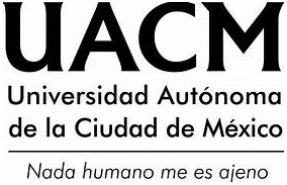THE IDIOMATIC PHRASES AND ITS ORAL LANGUAGE TYPOLOGY
DOI:
https://doi.org/10.29092/uacm.v0i1.58Keywords:
Tipología, géneros cortos, cultura, oralidadAbstract
A former investigation about the oral “idioms” typology. They are seen as cultural texts with specific uses and a peculiar memory and ideology functionning.
Downloads
References
ALTHUSSER, Louis, La filosofía como arma de la revolución. México: Pasado y Presente, 1985.
BAJTÍN, M. M. (1989) Estética de la creación verbal. México: Siglo XXI.
BERISTAIN, Helena. (1998) Diccionario de retórica y poética. México: Porrúa. DEY, Teresa. (2004) Apuntes inéditos. México: Universidad de la Ciudad de México.
FAYE, Jean Pierre. (1976) La crítica del lenguaje y su economía. Madrid: Alberto Corazón.
FOUCAULT, Michel. (1980) El orden del discurso. Barcelona, Tusquets.
GRIJALBO. (1985) Diccionario enciclopédico. México: Grijalbo. GRIZE, Jean Blaise. (1973) “Logique et discours pratique” en Revue Communications, núm. 20. París: Seuil.
______, (1996) Logique Naturelle et Communications. París: PUF.
GUMPERZ, John. (1992) Contextualization and Understanding. Rethinking Context. A. Duranti & Ch. Godwin (eds.) Cambridge: Cambridge University Press.
GUZMÁN, Josefina. (1997) La lengua no tiene hueso. Discurso y refrán [Tesis de licenciatura]. México: Escuela Nacional de Antropología e Historia.
______, (2000) La muerte es flaca y no ha de poder conmigo. Análisis del discurso de la muerte en situación comunicativa [Tesis de maestría en lingüística]. México: Escuela Nacional de Antropología e Historia.
HAIDAR, Julieta. (2000) El debate del CEU-Rectoría; estrategias discursivas [Tesis doctoral]. México: Facultad de Ciencias Políticas de la UNAM.
______, (1998) en Jesús Galindo Cáceres, Técnicas de investigación en sociedad, cultura y comunicación. México: Addison Wesley Longman-Consejo Nacional para la Cultura y las Artes.
HYMES, Dell. (1974) Foundations in Sociolinguistics. An Ethnographic Approach. Philadelphia: University of Pennsylvania Press.
JAKOBSON, Roman. (1986) Ensayos de poética. México: Fondo de Cultura Económica.
______, (1988) El marco del lenguaje. México: Fondo de Cultura Económica. LOTMAN, J. J. (1976) Semiótica de la cultura. Madrid: Cátedra.
MEJÍA PRIETO, Jorge. (1985) Albures y refranes de México: México: Panorama. ONG, Walter J. (1987) Oralidad y escritura. Tecnologías de la palabra. México: Fondo de Cultura Económica.
PÊCHEUX, Michel. (1975) “Formación social, lengua, discurso” en Arte, Sociedad, Ideología, núm. 5. México. [Original en Langages, núm. 37. París: Didier Larousse, marzo, 1975].
______, (1969) Hacia el análisis automático del discurso. Madrid: Gredos.
PERELMAN, Chaïm y Lucy Olbrechts-Tyteca. (1958) La nueva retórica. Tratado de la argumentación. Madrid: Gredos. PÉREZ MARTÍNEZ, Herón. (1993) Refrán viejo nunca muere. México: El Colegio de Michoacán.
______, (1997) Refrán viejo nunca miente, 1a reimp. México: El Colegio de Michoacán. ROBIN, Régine. (1977) “El campo semántico de la feudalidad” en Estudios de Historia Social, núms. 2-3. México, julio-diciembre.
REYGADAS, Pedro. (1995) Taller del cocodrilo. México: Praxis. SELECTOR. (1994) Las mejores frases célebres. México: Selector.
USPENSKI, J. B. A. (1979) “Historia sub-especie semiótica” en Iuri Lotman, Semiótica de la cultura. Madrid: Cátedra.
VERON, Eliseo. (s/f) “Ideología y comunicación de masas: La semantización de la violencia y política” en Lenguaje y comunicación social. Buenos Aires: Nueva Visión.
Published
Issue
Section
License
This Journal is licensed under Creative Commons Mexico 2.5. It is allowed to reproduce and disseminate the contents of the Journal for educational or research purposes, not for profit, as long as they are not mutilated and cite the source (Andamios, Revista de Investigación Social) and the author.
The copyright of the articles published in Andamios, Revista de Investigación Social are transferred by the author(s) to Universidad Autónoma de la Ciudad de México when the originals have been accepted, so that they are published and distributed both in the printed and electronic versions of the Journal. However, as established by law, the author(s) retains their moral rights. The author(s) will receive a form of assignment of copyright that they must to sign when their original has been accepted. In the case of collective articles, the signature of one of the authors will suffice, provided that the latter has obtained the consent of the others.
Authors may use the material of their article in other works or books published by themselves, with the condition of quoting Andamios as the original source of the texts.
The articles contained in this publication are the responsibility of their authors and do not compromise the official position of Andamios, Revista de Investigación Social of the Universidad Autónoma de la Ciudad de México.


